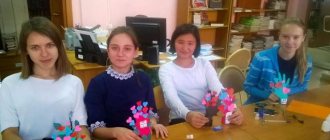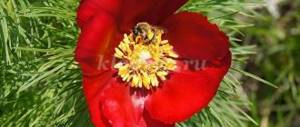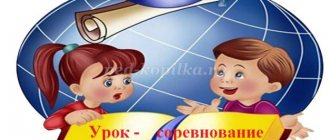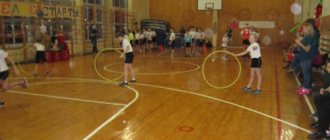Day of the Unknown Soldier (classroom development, with presentation)
Job title:
Class hour (with presentation) on the topic “Day of the Unknown Soldier”
Nomination: methodological developments
Type of work: methodological development of class hours
Author:
teacher of history and social studies, Municipal Educational Institution Secondary School, Apalikha village, Khvalynsky district, Saratov region, Anatoly Ivanovich Evseev
Class hour (with presentation) on the topic: Day of the Unknown Soldier (December 3)
Goals:1.
Education of citizenship and patriotism in children, based on the heroic fate of the people of Russia.
2. Students study the history of military valor and immortal exploits of Russian and Soviet soldiers who died during the Great Patriotic War.
3. Expansion of historical knowledge and ideas.
4. Propaganda of memorable dates in the history of Russia with an explanation of the history of their occurrence and significance for our country.
Progress of the event.
- Listening to a recording of the song performed by I. Kobzon “The Ballad of the Unknown Soldier”.
- Introductory word from the teacher.
— The Tomb of the Unknown Soldier Memorial is located in Moscow in the Alexander Garden, near the northern wall of the Kremlin. The composition is a tombstone (slide 2),
on which rests a bronze battle banner. On the battle banner lie a soldier's helmet and a laurel branch, also made of bronze.
In the center of the memorial there is a niche, in the middle of which, in a bronze five-pointed star, the Eternal Flame of Glory burns. Next to the fire there is an inscription made of labradorite: “ Your name is unknown, your feat is immortal”
(author S. V. Mikhalkov)(
slide 3)
- The history of the appearance of the monument.
— The history of the appearance of this monument in Moscow is very interesting. Victory in the Great Patriotic War began to be widely celebrated only in 1965. At the same time, Moscow received the title of hero city, and May 9th became a national holiday. In December 1966, Moscow was planning to solemnly celebrate the 25th anniversary of the defeat of German troops near Moscow. Then the first secretary of the Moscow City Party Committee was N.G. Egorychev, who came up with the idea of creating a monument to the soldiers who fought and died in battles near Moscow. But it was clear to him that this monument should not be of local significance, but of national importance, and such a monument could become the monument to the Unknown Soldier.
Despite the obvious correctness of the idea, the project was not implemented immediately. Head of the USSR L.I. Brezhnev categorically did not approve of the Alexander Garden as an installation site. In addition, problems could arise with moving the obelisk in honor of the 300th anniversary of the Romanovs, which, on the initiative of V.I. Lenin was converted into a monument to revolutionary figures.
It was not easy to decide who should be buried near the Kremlin walls. How to choose a body? What if it turns out to be a deserter? In those days, near Moscow, in Zelenograd, during construction work, a mass grave from the war was discovered, and it was decided to choose the deceased from here. The choice was made on a warrior in a well-preserved uniform without insignia. Wartime experts argued that if this soldier had been a deserter, he would not have been wearing a belt. This soldier could not have been captured either, because... The Germans did not reach this place. There were no documents with the fighter - his ashes were truly nameless.
The military developed a solemn ritual for the burial. The ashes of an unknown soldier were delivered to Moscow from Zelenograd on a gun carriage ( slide 4
), from the 41st kilometer of Leningradskoye Highway on December 3, 1966.
That morning, along Gorky Street, along which the motorcade was moving to Manezhnaya Square, was filled with people ( slide 5
).
The last meters to the burial site in the Alexander Garden, the coffin with ashes was carried by party leaders and Marshal Rokossovsky ( slide 6
). It is noteworthy that Marshal Zhukov, whose monument now stands on Manezhnaya Square, was not given the honor of carrying his remains; he was then in disgrace.
On May 8, 1967, according to the design of architects D. I. Burdin, V. A. Klimov, Yu. R. Rabaev and sculptor N. V. Tomsky, the Tomb of the Unknown Soldier memorial was opened here. The eternal flame was delivered from Leningrad, from the war memorial on the Field of Mars, and it was lit at the Tomb of the Unknown Soldier personally by L.I. Brezhnev ( slide 7),
accepting the torch from the hands of Hero of the Soviet Union A.P. Maresyeva.
- A student's story (Sasha Viryasov)
“Many years have passed since then, but this monument continues to remain one of the most famous in the whole country. Adults and children come here not only on Victory Day. The newlyweds ( slide
7
), foreign delegations and leading Russian officials (
slide 8
), and the Patriarch of All Russia (
slide 9
) lay flowers at the Eternal Flame, showing endless respect to the nameless heroes.
Soldiers and officers of the Presidential Regiment march at the monument to the Unknown Soldier on memorable days ( slide 10
).
On December 12, 1997, by Decree of the President of Russia, post No. 1 with an honor guard was moved from the Lenin Mausoleum to the Tomb of the Unknown Soldier ( slide 11
). The guard is carried out by soldiers of the Presidential Regiment, changing every hour. In 2009, the monument was given the status of a National Military Glory Memorial, and reconstruction of the memorial began. During the reconstruction, the Eternal Flame was moved to Poklonnaya Hill, and on February 23, 2010, after completion, it was returned to the Kremlin wall.
On the eve of Victory Day, on May 8, 2010, the National Memorial of Military Glory was inaugurated after reconstruction ( slide 12
). The ceremony was attended by the presidents of Russia, Belarus and Ukraine. On this day, a stele was unveiled in memory of the cities of military glory; it was opened by twice Hero of the Soviet Union Mikhail Odintsov and Hero of Russia Vyacheslav Sipko.
5. Hero Cities and Cities of Military Glory
On the left side of the monument there is a wall made of crimson quartzite with the inscription: “1941 To those who fell for the Motherland 1945”, and on the right side there is a granite alley ( slide 13),
along which there are blocks of dark red porphyry.
On each block the name of the hero city is carved and a Gold Star medal is depicted. Inside the blocks there are capsules with earth brought from these hero cities ( slide 14)
- “Leningrad” (from Piskarevsky cemetery),
- “Kyiv” (from the foot of the Obelisk to the participants in the defense of the city),
- “Stalingrad” (from Mamayev Kurgan) - until September 2004 the inscription read “Volgograd”[2],
- "Odessa" (from the defense lines),
- "Sevastopol" (from Malakhov Kurgan),
- "Minsk" (from the defense lines),
- "Kerch" (from the defense lines),
- "Novorossiysk" (from the defense lines),
- "Brest Fortress" (from the foot of the walls),
- "Tula" (from the defense lines),
- "Murmansk" (from the defense lines),
- "Smolensk" (from the defense lines).
On the right there is a granite stele lying on a pedestal - this is a new element of the memorial, which appeared here in 2010. The stele is made of red granite, its height is about a meter, and its length is 10 meters. The stele stretches almost all the way to the Ruin grotto. On its left side you can see the gilded inscription “CITIES OF MILITARY GLORY”, and along the pedestal are the names of 27 cities of military glory ( slide 15
):
| Belgorod | Malgobek | Voronezh | Tuapse | Vyazma | Kozelsk | Nalchik | Tikhvin | Stary Oskol | Taganrog |
| Kursk | Rzhev | Meadows | Velikie Luki | Kronstadt | Arkhangelsk | Vyborg | Tver | Kovrov | Maloyaroslavets |
| Eagle | Yelnya | Polar | Velikiy Novgorod | Naro-Fominsk | Volokolamsk | Kalach-on-Don | Anapa | Lomonosov | Mozhaisk |
| Vladikavkaz | Dace | Rostov-on-Don | Dmitrov | Pskov | Bryansk | Vladivostok | Kolpino | Petropavlovsk-Kamchatsky | Khabarovsk |
In 2013, the All-Russian public movement to perpetuate the memory of those killed in defense of the Fatherland “Search Movement of Russia” for the first time held the all-Russian action “Day of the Unknown Soldier” in Russia. In September 2014, during a meeting between the head of the Presidential Administration Sergei Ivanov and participants in the specialized search shift at the Ocean Children's Center, participants in the movement proposed making this day - December 3 - a memorable date in Russia - the Day of the Unknown Soldier.
- Watch a video about the changing of the guard at the Tomb of the Unknown Soldier.
Internet resources:
- https://ru.wikipedia.org/wiki/%D0%9C%D0%BE%D0%B3%D0%B8%D0%BB%D0%B0_%D0%9D%D0%B5%D0%B8%D0 %B7%D0%B2%D0%B5%D1%81%D1%82%D0%BD%D0%BE%D0%B3%D0%BE_%D0%A1%D0%BE%D0%BB%D0%B4 %D0%B0%D1%82%D0%B0
- https://defendingrussia.ru/love/mogila_neizvestnogo_soldata_fakty
- https://www.aif.ru/society/history/1033871
- https://musei-smerti.ru/mogila-neizvestnogo-soldata-48-let-pamyati/
- https://visualhistory.livejournal.com/902413.html
- https://www.google.ru/search?q=grave+of the+unknown+soldier+in+Moscow&newwindow=1&sa=N&espv=2&biw=1600&bih=775&tbm








